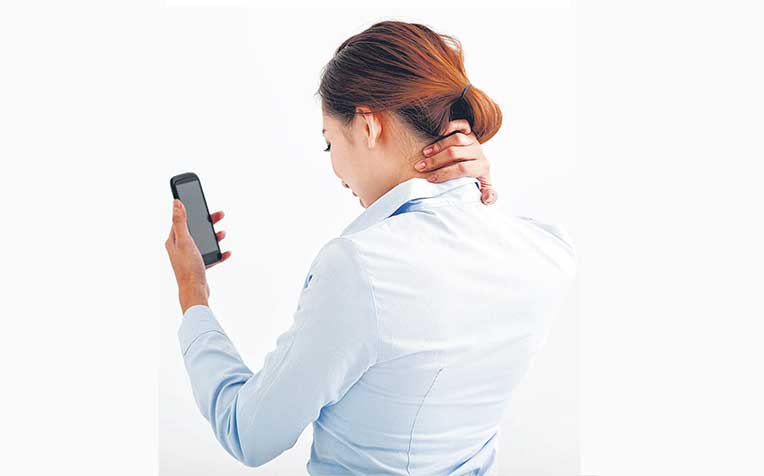
while reading a hand-held device can exert 18kg of stress on the spine.
Heavy users of mobile devices are susceptible to injury if they do not maintain good posture, but most are not aware of the risks.
A Singapore survey of more than 500 young adults between 21 and 29 showed that more than eight in 10 of them spent three or more hours on their mobile phones and tablets. And six in 10 had neck and back pain after using their devices.
However, only 11 per cent had accurate knowledge of “text neck” syndrome, a type of repetitive stress injury linked to the use of mobile phones, which could be the cause of the pain they were experiencing.
The survey was conducted by four final-year undergraduates from the Wee Kim Wee School of Communication and Information at Nanyang Technological University (NTU).
Following the survey, they started a campaign to raise awareness of the syndrome.
A check with Singapore General Hospital (SGH), Khoo Teck Puat Hospital (KTPH) and National University Hospital showed an upward trend of patients with neck issues.
However, doctors were hesitant to attribute the rise in numbers to mobile phone usage.
Dr David Choy, a specialist in neurosurgery and consultant at Raffles Neuroscience Centre, said: “Text neck is one contributing factor but there are also many other factors, such as one’s posture at work and gym-related activities like weight-lifting.”
KTPH principal physiotherapist Ram Peruvemba said it may take 10 more years to see the full extent of the impact of mobile use on younger people.
“We expect it to be a problem in the future, as it is common to bend the neck when using mobile phones and tablets,” he said.
A 30-degree downward tilt can exert 18kg of stress on the spine, according to research published in Surgical Technology International, a United States-based publication.
Headded that it is common to see teenagers bent over their smartphones and children playing games on their parent’s mobile phone or watching a video on it.
“They need to adopt good posture habits now to prevent health problems later in life, which may occur after decades of using a hand-held device,” he said.
One of the NTU students in the campaign group was diagnosed with cervical spondylosis – degeneration of the neck and spine – when he was 22 and doing his national service.
It was only after further research into technology-induced injuries that Mr Dannie Seet, 26, realised his condition may have been related to “text neck”.
He said: “I remember that during my polytechnic days, I was always in a hunched position, using my laptop and mobile devices.”
Doctors prescribed supplements to strengthen his nerves and simple exercises to alleviate the pain.
After finding out more about “text neck”, he and his group decided to start a campaign, Stand Corrected, to warn their peers about the condition.
The survey showed that few people knew enough about the damage being done to their spines, which could be avoided.
One of the campaign’s recommendations was to hold the hand-held devices at eye level.
Dr Mohammad Mashfiqul Arafin Siddiqui, a consultant at SGH’s department of orthopaedic surgery, said that maintaining good posture, as well as taking regular breaks from repetitive tasks and doing adequate stretching, can help minimise the risk of injury.
He said: “The condition is reversible if detected and managed early, but I would like to stress that prevention is most important.”
Contributed by














 Get it on Google Play
Get it on Google Play